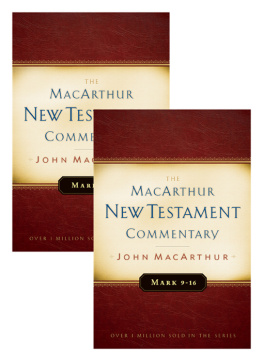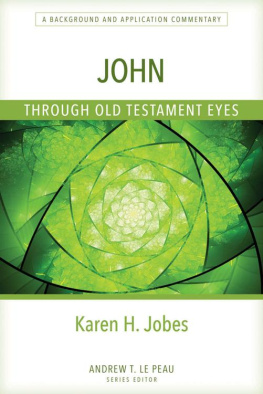Scot McKnight - Introducing New Testament Interpretation
Here you can read online Scot McKnight - Introducing New Testament Interpretation full text of the book (entire story) in english for free. Download pdf and epub, get meaning, cover and reviews about this ebook. year: 1990, publisher: Baker Publishing Group, genre: Religion. Description of the work, (preface) as well as reviews are available. Best literature library LitArk.com created for fans of good reading and offers a wide selection of genres:
Romance novel
Science fiction
Adventure
Detective
Science
History
Home and family
Prose
Art
Politics
Computer
Non-fiction
Religion
Business
Children
Humor
Choose a favorite category and find really read worthwhile books. Enjoy immersion in the world of imagination, feel the emotions of the characters or learn something new for yourself, make an fascinating discovery.
- Book:Introducing New Testament Interpretation
- Author:
- Publisher:Baker Publishing Group
- Genre:
- Year:1990
- Rating:4 / 5
- Favourites:Add to favourites
- Your mark:
- 80
- 1
- 2
- 3
- 4
- 5
Introducing New Testament Interpretation: summary, description and annotation
We offer to read an annotation, description, summary or preface (depends on what the author of the book "Introducing New Testament Interpretation" wrote himself). If you haven't found the necessary information about the book — write in the comments, we will try to find it.
Introducing New Testament Interpretation — read online for free the complete book (whole text) full work
Below is the text of the book, divided by pages. System saving the place of the last page read, allows you to conveniently read the book "Introducing New Testament Interpretation" online for free, without having to search again every time where you left off. Put a bookmark, and you can go to the page where you finished reading at any time.
Font size:
Interval:
Bookmark:
Guides to New Testament Exegesis
Scot McKnight, General Editor
- Introducing New Testament Interpretation , ed. Scot McKnight
- Interpreting the Synoptic Gospels , Scot McKnight
- Interpreting the Gospel of John , Gary M. Burge
- Interpreting the Book of Acts , Walter L. Liefeld
- Interpreting the Pauline Epistles , Thomas R. Schreiner
- Interpreting the Epistle to the Hebrews , Andrew H. Trotter, Jr.
- Interpreting the Book of Revelation , J. Ramsey Michaels

Copyright 1989 by Scot McKnight
Published by Baker Academic
a division of Baker Publishing Group
P.O. Box 6287, Grand Rapids, MI 49516-6287
bakeracademic.com
Ebook edition created 2012
All rights reserved. No part of this publication may be reproduced, stored in a retrieval system, or transmitted in any form or by any meansfor example, electronic, photocopy, recordingwithout the prior written permission of the publisher. The only exception is brief quotations in printed reviews.
ISBN 978-1-4412-0683-1
Library of Congress Cataloging-in-Publication Data is on file at the Library of Congress, Washington, DC.
Contents
James D. G. Dunn
Warren Heard
Michael W. Holmes
Scot McKnight
Darrell L. Bock
Thomas E. Schmidt
L. D. Hurst
Craig A. Evans
Editors Preface to Series
F our literary types (genres) comprise the New Testament: the Gospels, the Acts of the Apostles, the Letters, and, finally, the Apocalypse. Each genre is distinct, and, as has been made abundantly clear by contemporary scholars, each requires different sensitivities, principles, and methods of interpretation. Consequently, applying the same method to different genres will often lead to serious misunderstandings. Consequently, students need manuals that will introduce them both to the specific nature of a particular genre and to basic principles for exegeting that genre.
The Guides to New Testament Exegesis series has been specifically designed to meet this need. These guides have been written, not for specialists, but for college religion majors, seminarians, and pastors who have had at least one year of Greek. Methods and principles may change, but the language of the New Testament remains the same. God chose to speak to people in Greek; serious students of the New Testament must learn to love that language in order better to understand the Word of God.
These guides also have a practical aim. Each guide presents various views of scholars on particular issues. Yet the ultimate goal of each is to provide methods and principles for interpreting the New Testament. Abstract discussions have their proper place but not in this series; these guides are intended for concrete application to the New Testament text. Various scholars, specializing in given areas of New Testament study, offer students their own methods and principles for interpreting specific genres of the New Testament. Such diversity provides a broader perspective for the student. Each volume concludes with a bibliography of twenty essential works for further study.
Previously the point was made that different genres require different methods and principles. A basic exegetical method which can be adapted to various genres, however, is also essential. Because of the inevitable overlap of procedures, this introductory volume to the series covers the basic methods and principles for each genre. The individual exegetical guides will then introduce the student to more specific background procedures for that particular genre.
The vision for this series comes from Gordon Fees introduction to New Testament exegesis.
Finally, this series is dedicated to our teachers and students, in thanksgiving and hope. Our prayer is that God may use these books to lead his people into truth, love, and peace.
Scot McKnight
Editors Preface to Introducing New Testament Interpretation
G uides to New Testament Exegesis is based on the important premise that different genres deserve their own handbooks of interpretive principles. Hence, Guides plans volumes on each genre in the NT: synoptic Gospels, the Gospel of John, Acts, Pauline letters, Hebrews, and a finale on apocalyptic for the Revelation given to John.
If it is true that different genres deserve their own methodological discussions, it is also clear that the methods for each genre overlap to some extent. No one doubts that grammatical analysis, word studies, textual criticism, etc., are required for each type of literature. Introducing New Testament Interpretation presents the steps of NT exegesis that are common to any kind of writing found in the NT. The essays presented here were assigned to scholars in the field. Each essayist was given the freedom to present the material as seemed best. Since the subject matter was evaluated in the light of what most students need to know, various procedures were followed. Whereas some survey the field, others have dug more deeply into one corner of that field.
Beginning students usually encounter a teacher who contends that the NT cannot be understood (very well, at least) without a comprehensive understanding of the Jewish and Graeco-Roman backgrounds. Students generally agree with this assertion and are stimulated to poke around in the sources. But where does one begin? The Old Testament? OT pseudepigrapha or Apocrypha? Dead Sea Scrolls? Josephus? Philo? The Greek magical papyri? Suetonius? The rabbis? Dr. W. Heard offers to the student a brief survey of the literature, events, and ideas that comprise NT background; further, he appends ample bibliography for those who have a mind to plow deeper in a given area. A careful reading of his essay will introduce the student to most of the facts and all of the sources the beginning student needs.
Every student of the Greek NT has had to learn the various sigla found in the apparatus of the Greek NT. But textual criticism finds few devoted participants. As one of the last doctoral students supervised under the brilliant eye of B. M. Metzger, M. W. Holmes ranks among the finest of young scholars who have walked the special path of textual criticism. His essay is designed to present the basic facts and procedures for doing textual criticism and he includes the most up-to-date charts for classifying external evidence.
Along with the vagaries of background and textual criticism, the student of exegesis also has to master the essential categories of Greek syntax. The third essay, written by the editor, is built on a statement heard when in seminary. I was told, by my Greek teacher, that exegesis is essentially understanding the genitive case, the article, and the aorist tense. Perhaps this is an overstatement; but from my own teaching experience I can say that if the student comes to terms with these features of the Greek sentence, that student will reap abundant harvests. To encourage systematic grounding in the features of grammar, an introduction to diagramming Greek sentences is also provided.
Of all the features of exegesis, none has been used (or abused) more than word study. In the light of the latest progress in word analysis, Dr. D. L. Bock presents and illustrates the essential steps of doing a word study. Students need to give special heed to the authors instructions on the fallacies commonly committed and to the careful attention given to meaning.
Recent NT study has turned toward integrating traditional methods with the humanities. In his doctoral thesis, Dr. T. E. Schmidt demonstrated the ability to utilize the methods now associated with NT sociology and evaluate current theories in light of those methods and the ancient texts. His essay in this volume presents a lucid introduction to the approaches associated with NT sociology. His careful definitions, comprehensive survey of the more influential studies to date, and judicious advice regarding integration will introduce students and teachers to the discipline and enable them to appreciate and assess this field now in full bloom.
Next pageFont size:
Interval:
Bookmark:
Similar books «Introducing New Testament Interpretation»
Look at similar books to Introducing New Testament Interpretation. We have selected literature similar in name and meaning in the hope of providing readers with more options to find new, interesting, not yet read works.
Discussion, reviews of the book Introducing New Testament Interpretation and just readers' own opinions. Leave your comments, write what you think about the work, its meaning or the main characters. Specify what exactly you liked and what you didn't like, and why you think so.















